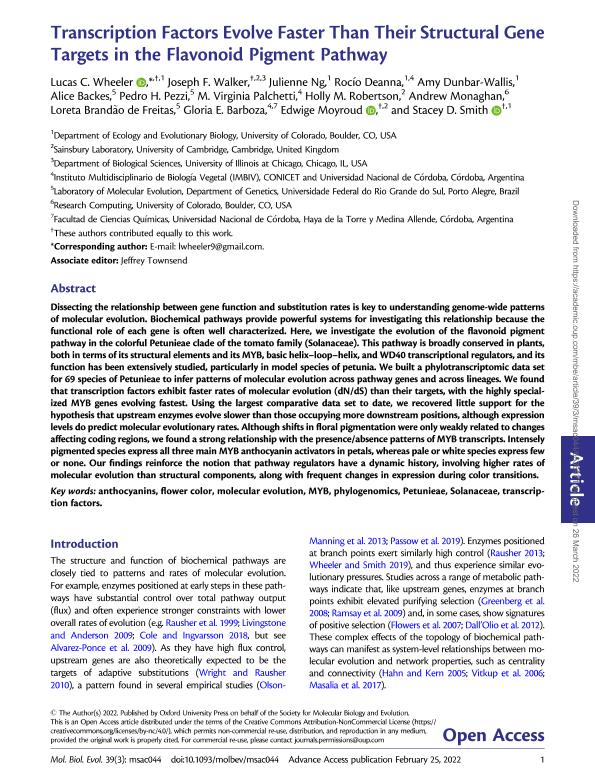Mostrar el registro sencillo del ítem
dc.contributor.author
Wheeler, Lucas C.
dc.contributor.author
Walker, Joseph F.
dc.contributor.author
Ng, Julienne
dc.contributor.author
Deanna, Rocío

dc.contributor.author
Dunbar Wallis, Amy
dc.contributor.author
Backes, Alice
dc.contributor.author
Pezzi, Pedro H.
dc.contributor.author
Palchetti, Maria Virginia

dc.contributor.author
Robertson, Holly M.
dc.contributor.author
Monaghan, Andrew
dc.contributor.author
de Freitas, Loreta Brandão
dc.contributor.author
Barboza, Gloria E.
dc.contributor.author
Moyroud, Edwige
dc.contributor.author
Smith, Stacey Dewitt

dc.date.available
2022-06-28T16:22:10Z
dc.date.issued
2022-03
dc.identifier.citation
Wheeler, Lucas C.; Walker, Joseph F.; Ng, Julienne; Deanna, Rocío; Dunbar Wallis, Amy; et al.; Transcription factors evolve faster than their structural gene targets in theflavonoid pigment pathway; Oxford University Press; Molecular Biology and Evolution; 39; 3; 3-2022; 1-15
dc.identifier.issn
0737-4038
dc.identifier.uri
http://hdl.handle.net/11336/160655
dc.description.abstract
Dissecting the relationship between gene function and substitution rates is key to understanding genome-wide patterns of molecular evolution. Biochemical pathways provide powerful systems for investigating this relationship because the functional role of each gene is often well characterized. Here, we investigate the evolution of the flavonoid pigment pathway in the colorful Petunieae clade of the tomato family (Solanaceae). This pathway is broadly conserved in plants, both in terms of its structural elements and its MYB, basic helix-loop-helix, and WD40 transcriptional regulators, and its function has been extensively studied, particularly in model species of petunia. We built a phylotranscriptomic data set for 69 species of Petunieae to infer patterns of molecular evolution across pathway genes and across lineages. We found that transcription factors exhibit faster rates of molecular evolution (dN/dS) than their targets, with the highly specialized MYB genes evolving fastest. Using the largest comparative data set to date, we recovered little support for the hypothesis that upstream enzymes evolve slower than those occupying more downstream positions, although expression levels do predict molecular evolutionary rates. Although shifts in floral pigmentation were only weakly related to changes affecting coding regions, we found a strong relationship with the presence/absence patterns of MYB transcripts. Intensely pigmented species express all three main MYB anthocyanin activators in petals, whereas pale or white species express few or none. Our findings reinforce the notion that pathway regulators have a dynamic history, involving higher rates of molecular evolution than structural components, along with frequent changes in expression during color transitions.
dc.format
application/pdf
dc.language.iso
eng
dc.publisher
Oxford University Press

dc.rights
info:eu-repo/semantics/openAccess
dc.rights.uri
https://creativecommons.org/licenses/by-nc-sa/2.5/ar/
dc.subject
ANTHOCYANINS
dc.subject
FLOWER COLOR
dc.subject
MOLECULAR EVOLUTION
dc.subject
MYB
dc.subject
PETUNIEAE
dc.subject
PHYLOGENOMICS
dc.subject
SOLANACEAE
dc.subject
TRANSCRIPTION FACTORS
dc.subject.classification
Bioquímica y Biología Molecular

dc.subject.classification
Ciencias Biológicas

dc.subject.classification
CIENCIAS NATURALES Y EXACTAS

dc.title
Transcription factors evolve faster than their structural gene targets in theflavonoid pigment pathway
dc.type
info:eu-repo/semantics/article
dc.type
info:ar-repo/semantics/artículo
dc.type
info:eu-repo/semantics/publishedVersion
dc.date.updated
2022-06-22T20:12:48Z
dc.identifier.eissn
1537-1719
dc.journal.volume
39
dc.journal.number
3
dc.journal.pagination
1-15
dc.journal.pais
Reino Unido

dc.journal.ciudad
Oxford
dc.description.fil
Fil: Wheeler, Lucas C.. State University of Colorado at Boulder; Estados Unidos
dc.description.fil
Fil: Walker, Joseph F.. University of Cambridge; Reino Unido. University of Illinois; Estados Unidos
dc.description.fil
Fil: Ng, Julienne. State University of Colorado at Boulder; Estados Unidos
dc.description.fil
Fil: Deanna, Rocío. Consejo Nacional de Investigaciones Científicas y Técnicas. Centro Científico Tecnológico Conicet - Córdoba. Instituto Multidisciplinario de Biología Vegetal. Universidad Nacional de Córdoba. Facultad de Ciencias Exactas Físicas y Naturales. Instituto Multidisciplinario de Biología Vegetal; Argentina. University of Colorado; Estados Unidos
dc.description.fil
Fil: Dunbar Wallis, Amy. State University of Colorado at Boulder; Estados Unidos
dc.description.fil
Fil: Backes, Alice. Universidade Federal do Rio Grande do Sul; Brasil
dc.description.fil
Fil: Pezzi, Pedro H.. Universidade Federal do Rio Grande do Sul; Brasil
dc.description.fil
Fil: Palchetti, Maria Virginia. Consejo Nacional de Investigaciones Científicas y Técnicas. Centro Científico Tecnológico Conicet - Córdoba. Instituto Multidisciplinario de Biología Vegetal. Universidad Nacional de Córdoba. Facultad de Ciencias Exactas Físicas y Naturales. Instituto Multidisciplinario de Biología Vegetal; Argentina
dc.description.fil
Fil: Robertson, Holly M.. University of Cambridge; Reino Unido
dc.description.fil
Fil: Monaghan, Andrew. State University of Colorado at Boulder; Estados Unidos
dc.description.fil
Fil: de Freitas, Loreta Brandão. Universidade Federal do Rio Grande do Sul; Brasil
dc.description.fil
Fil: Barboza, Gloria E.. Universidad Nacional de Córdoba; Argentina. Consejo Nacional de Investigaciones Científicas y Técnicas. Centro Científico Tecnológico Conicet - Córdoba. Instituto Multidisciplinario de Biología Vegetal. Universidad Nacional de Córdoba. Facultad de Ciencias Exactas Físicas y Naturales. Instituto Multidisciplinario de Biología Vegetal; Argentina
dc.description.fil
Fil: Moyroud, Edwige. University of Cambridge; Reino Unido
dc.description.fil
Fil: Smith, Stacey Dewitt. State University of Colorado at Boulder; Estados Unidos
dc.journal.title
Molecular Biology and Evolution

dc.relation.alternativeid
info:eu-repo/semantics/altIdentifier/doi/http://dx.doi.org/10.1093/molbev/msac044
dc.relation.alternativeid
info:eu-repo/semantics/altIdentifier/url/https://academic.oup.com/mbe/article/39/3/msac044/6536971
Archivos asociados
